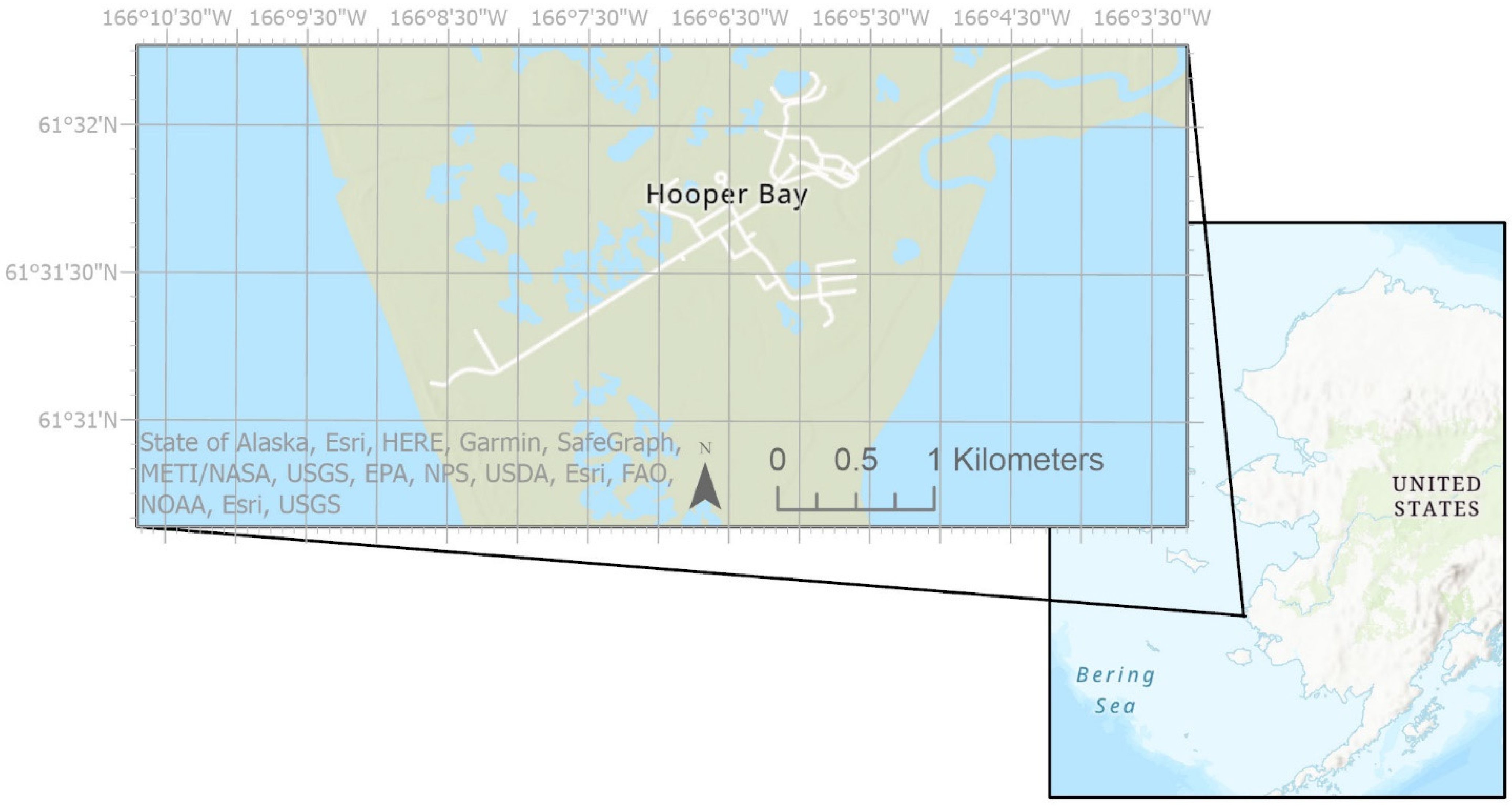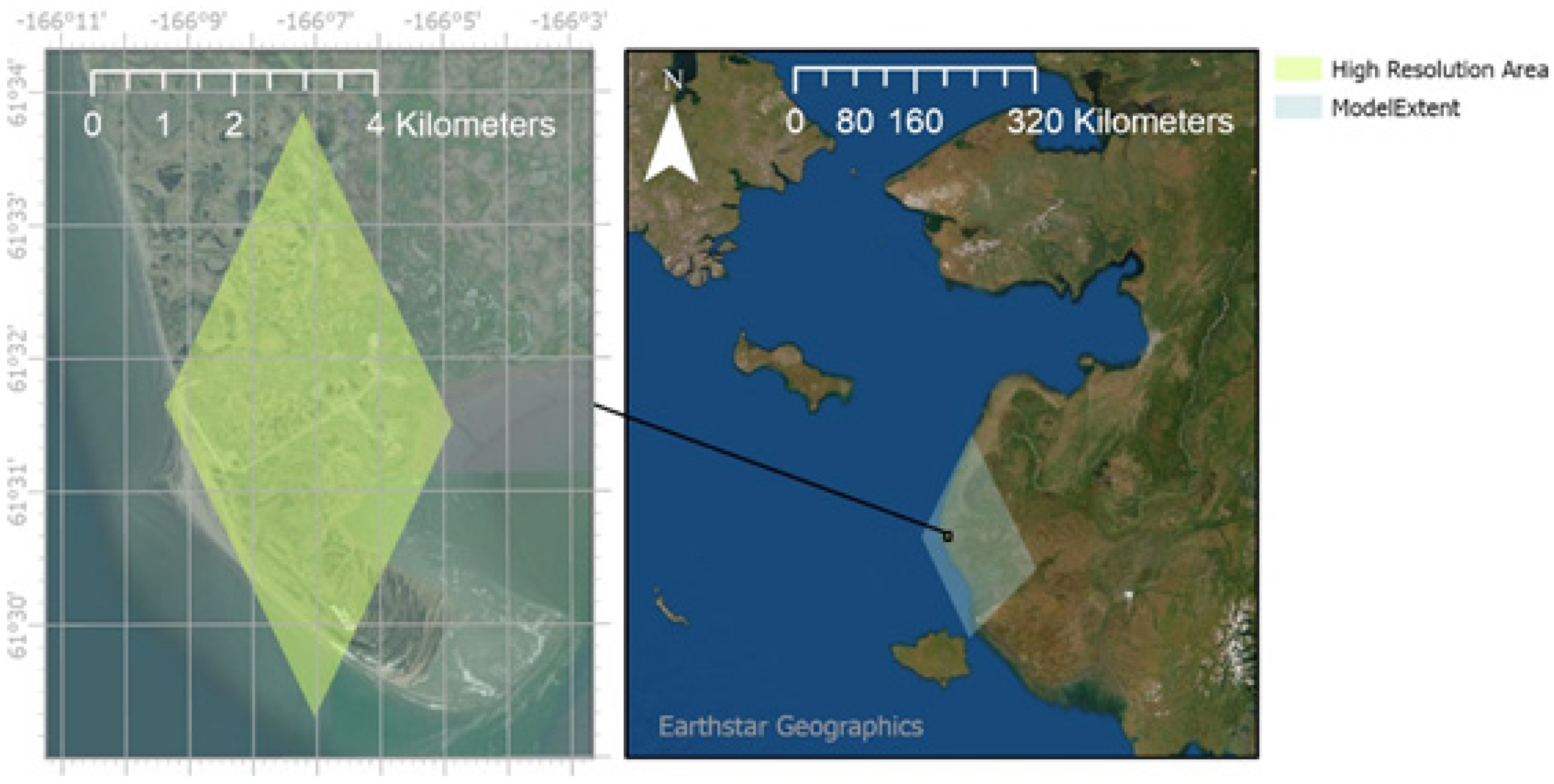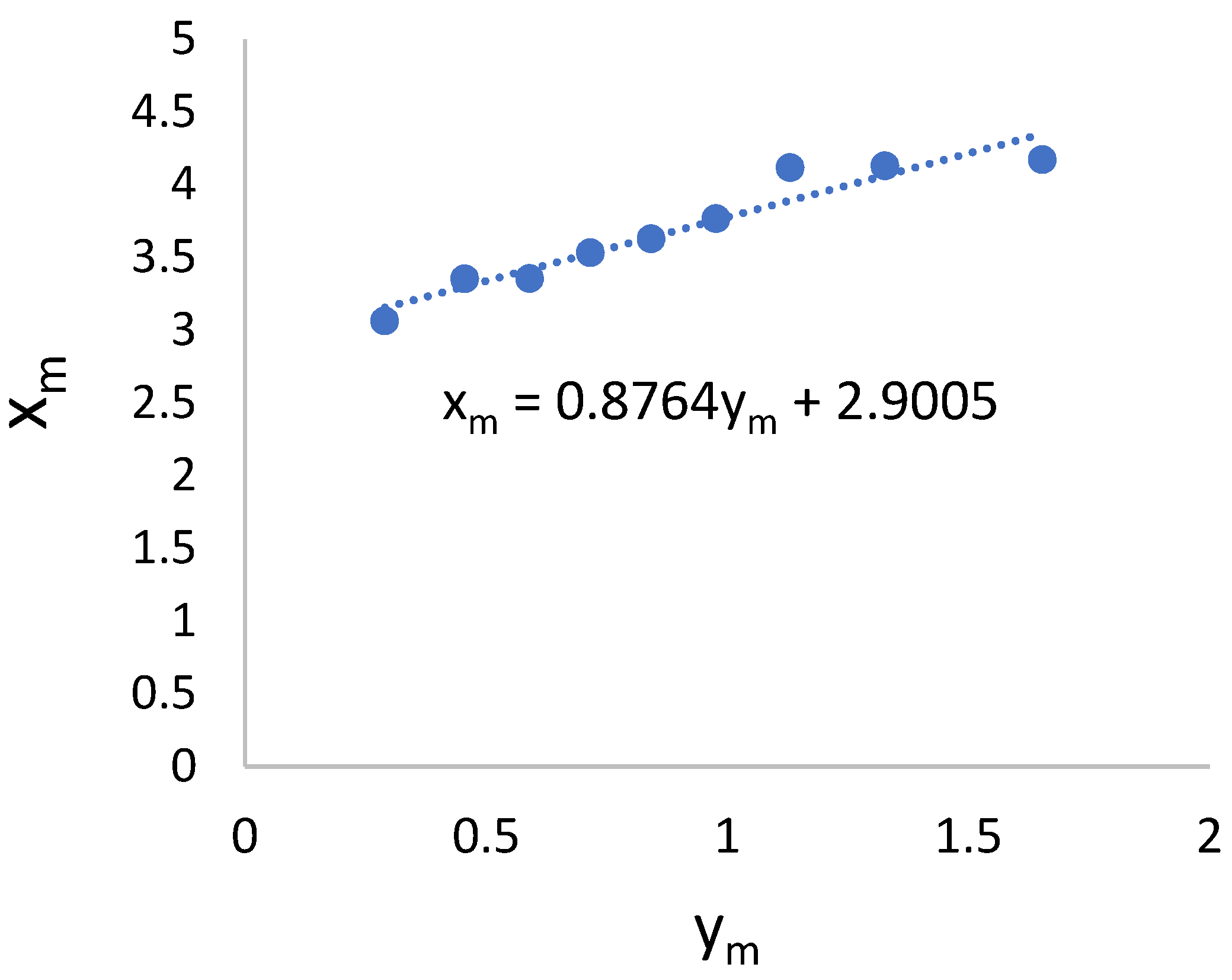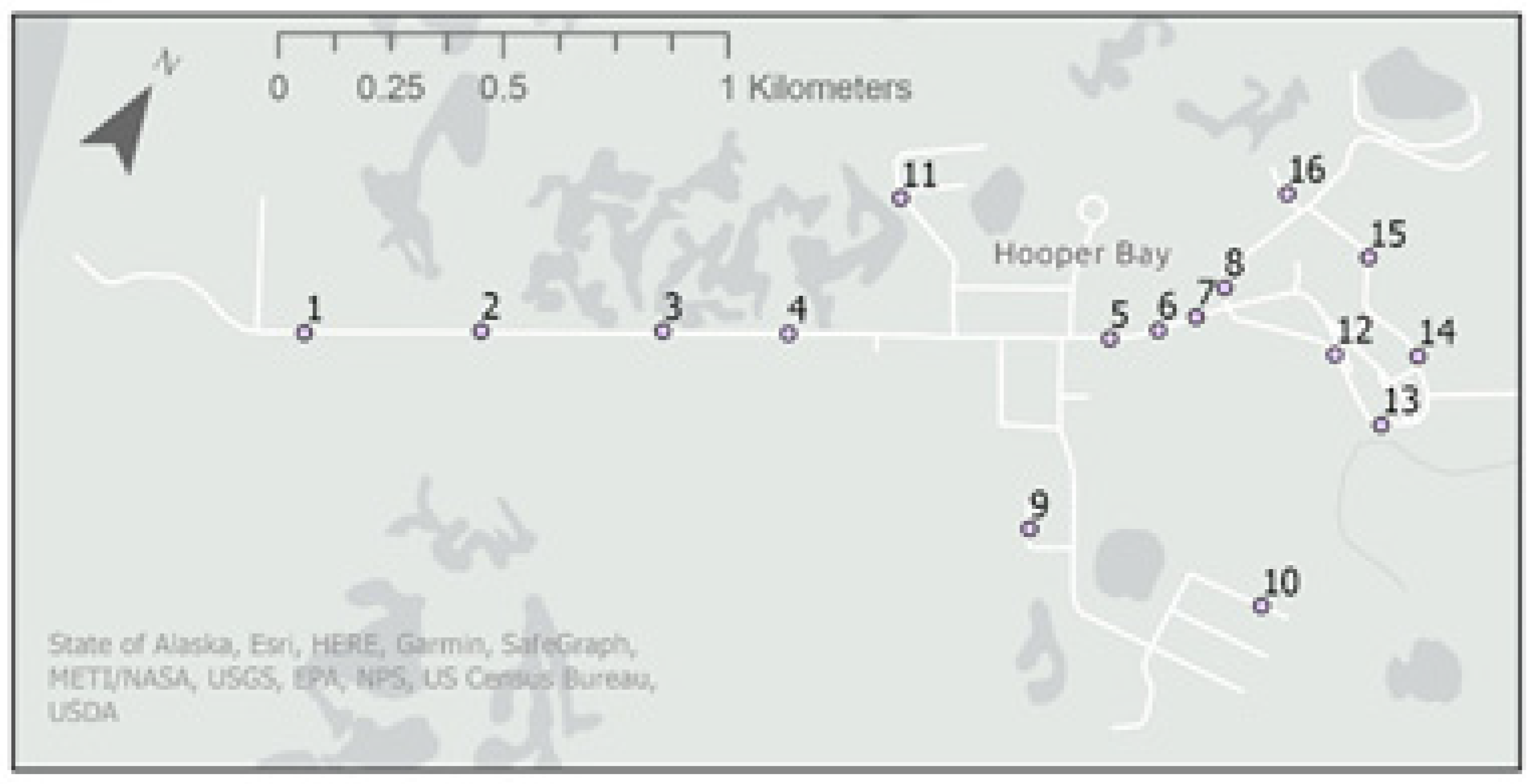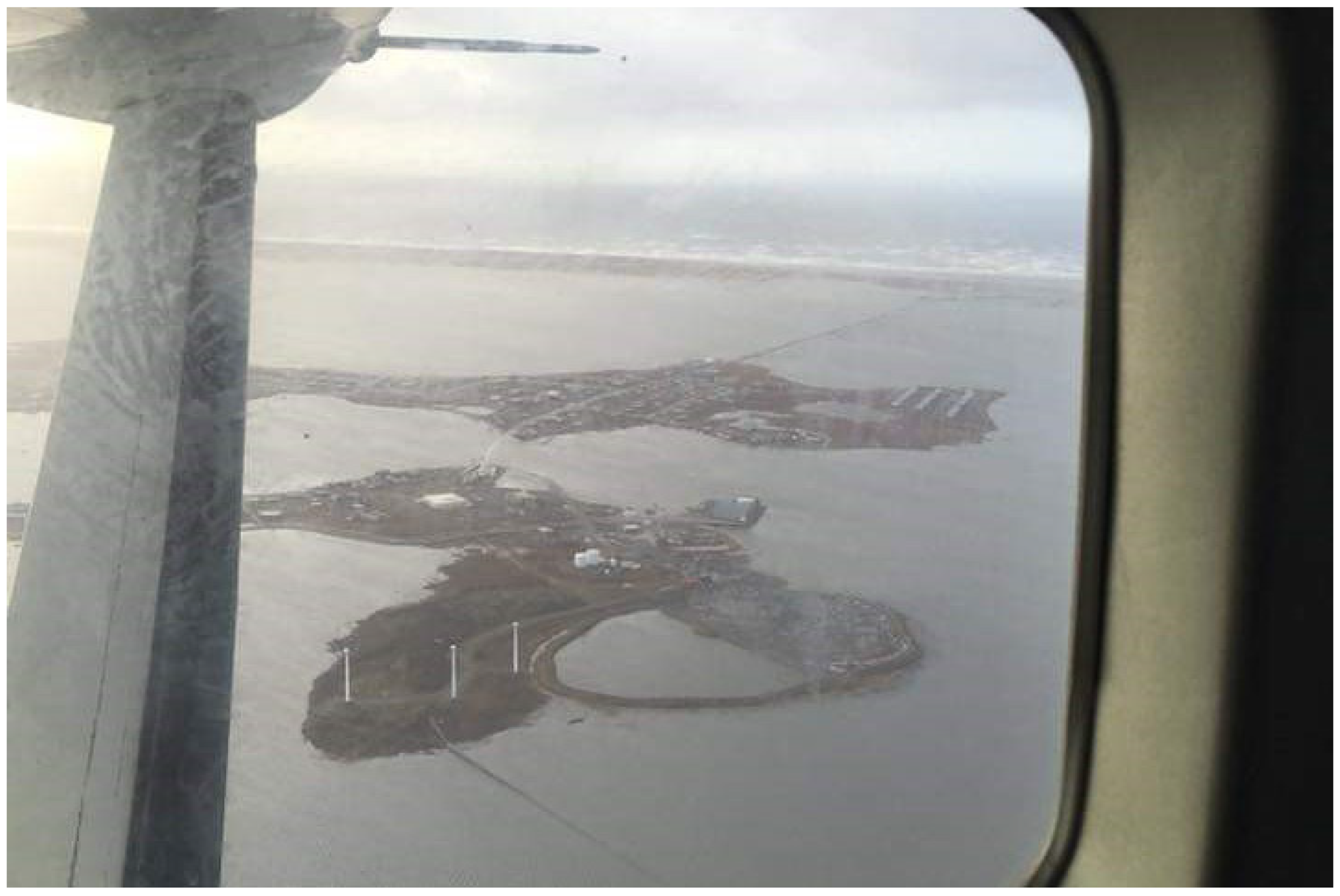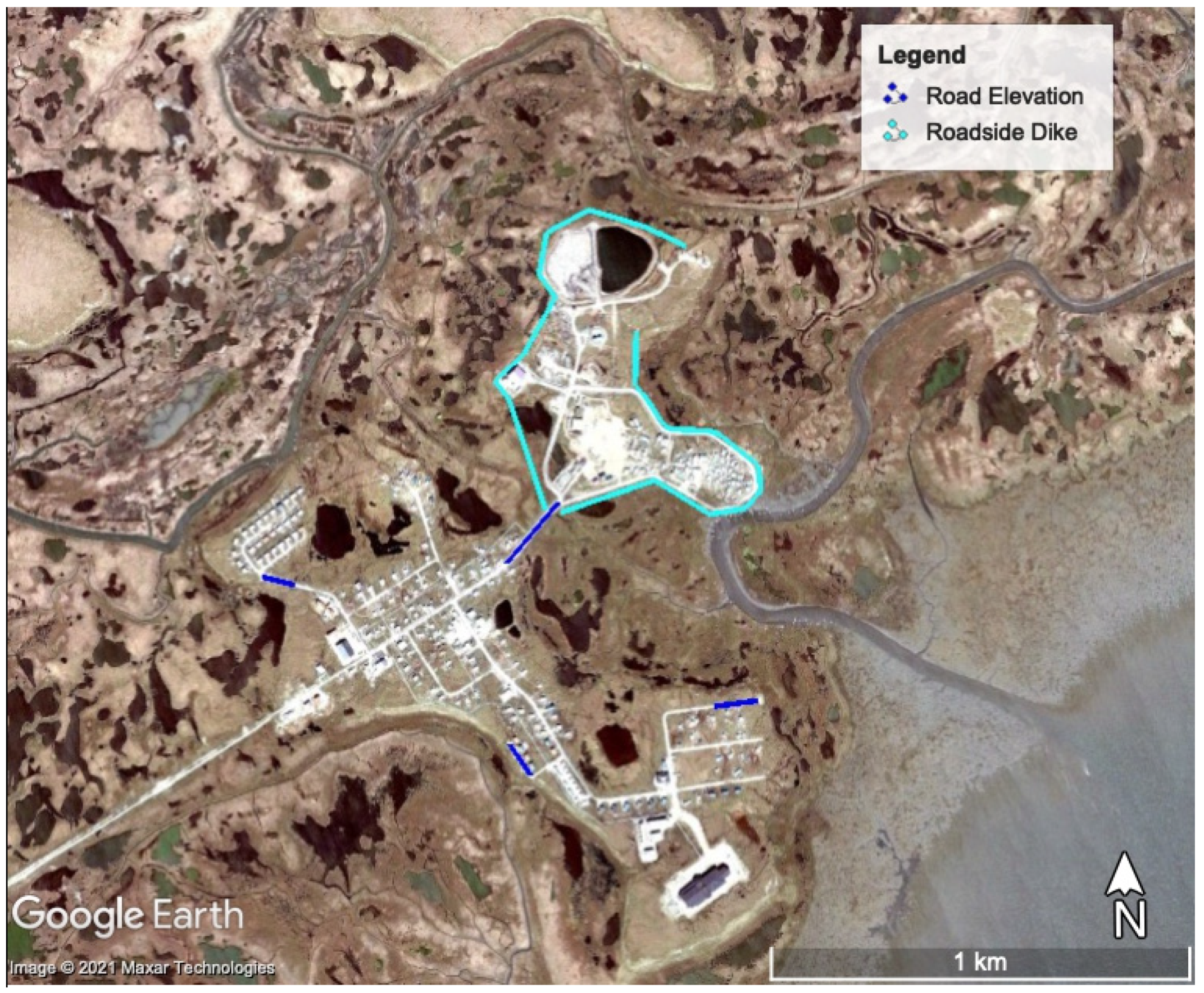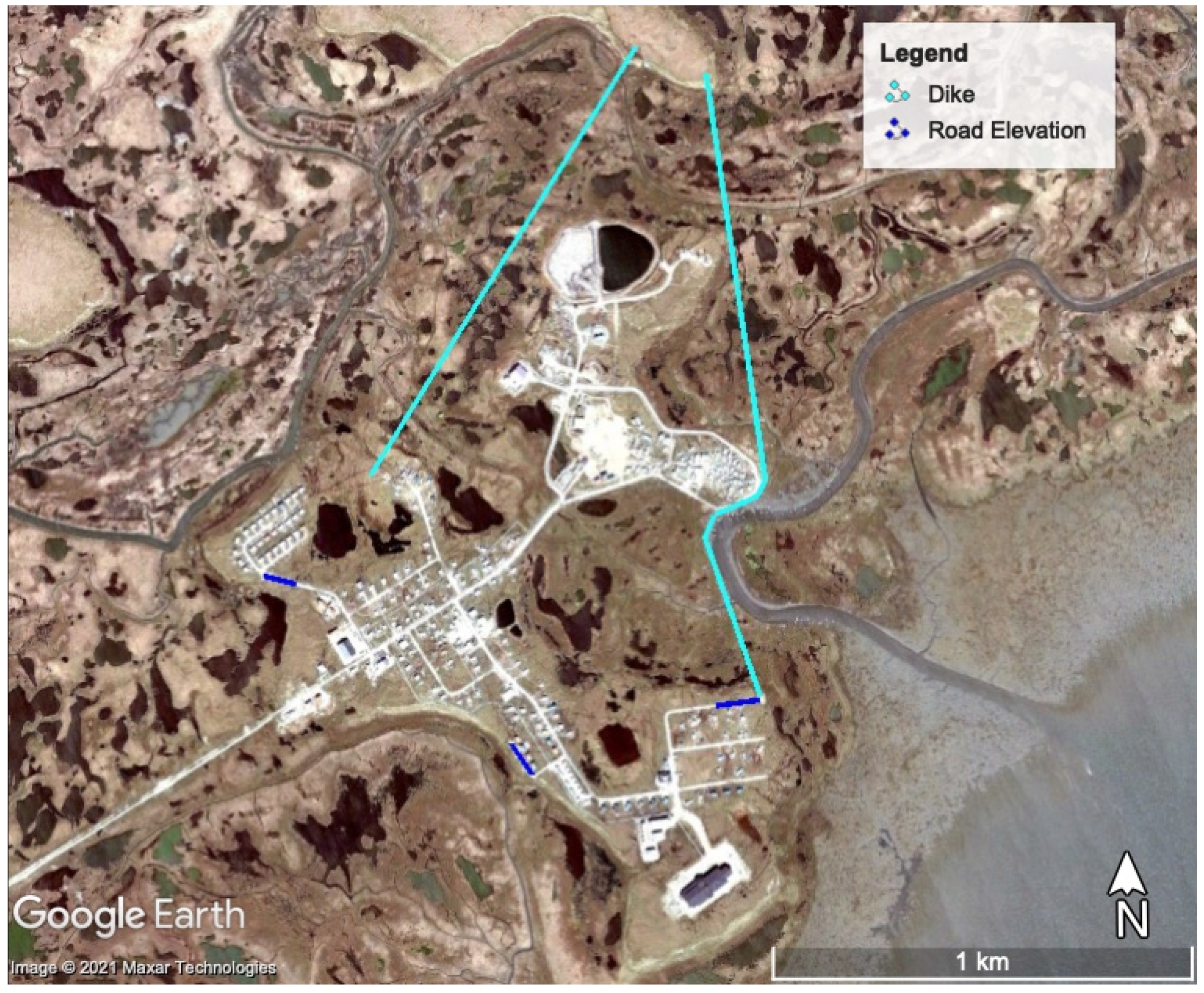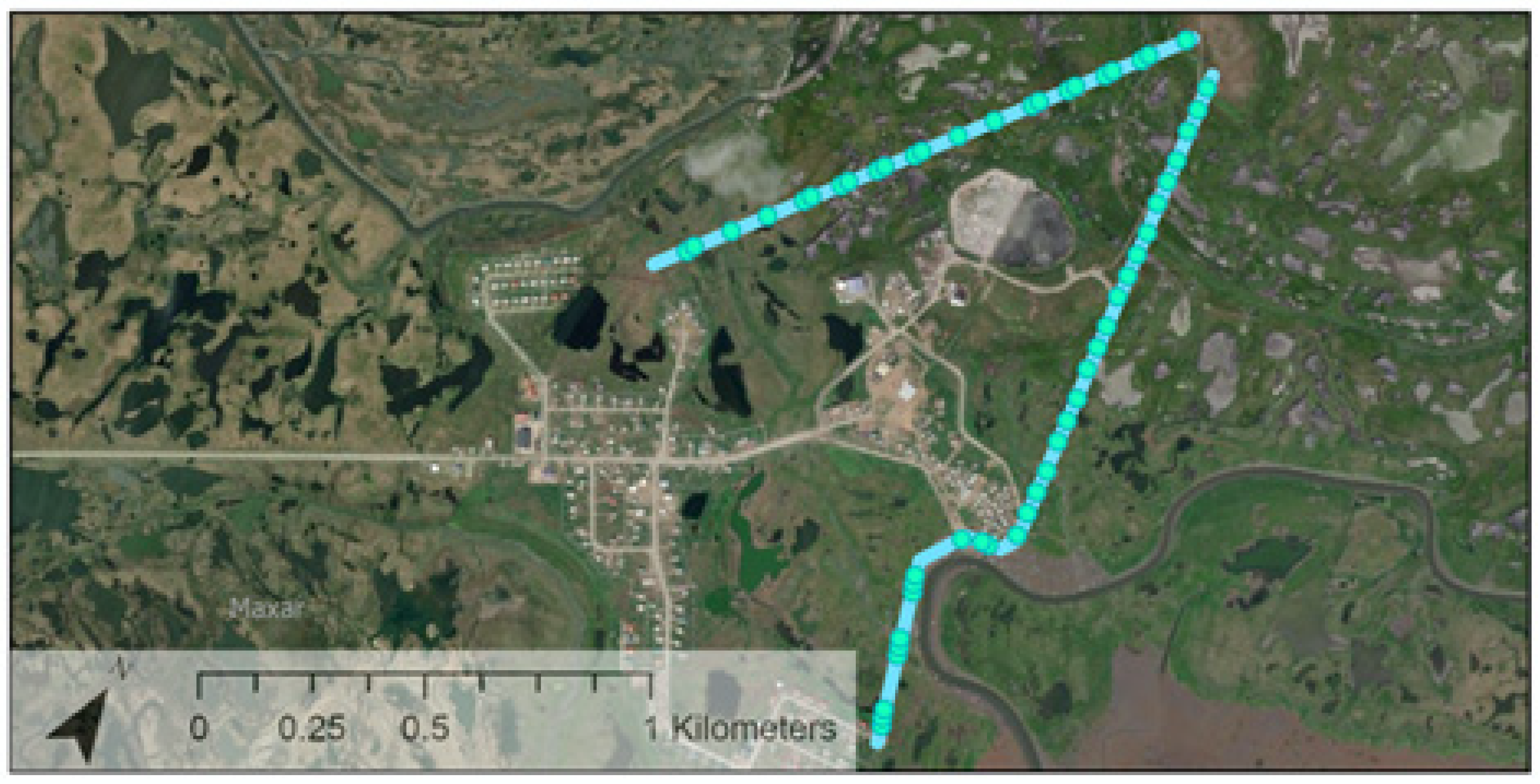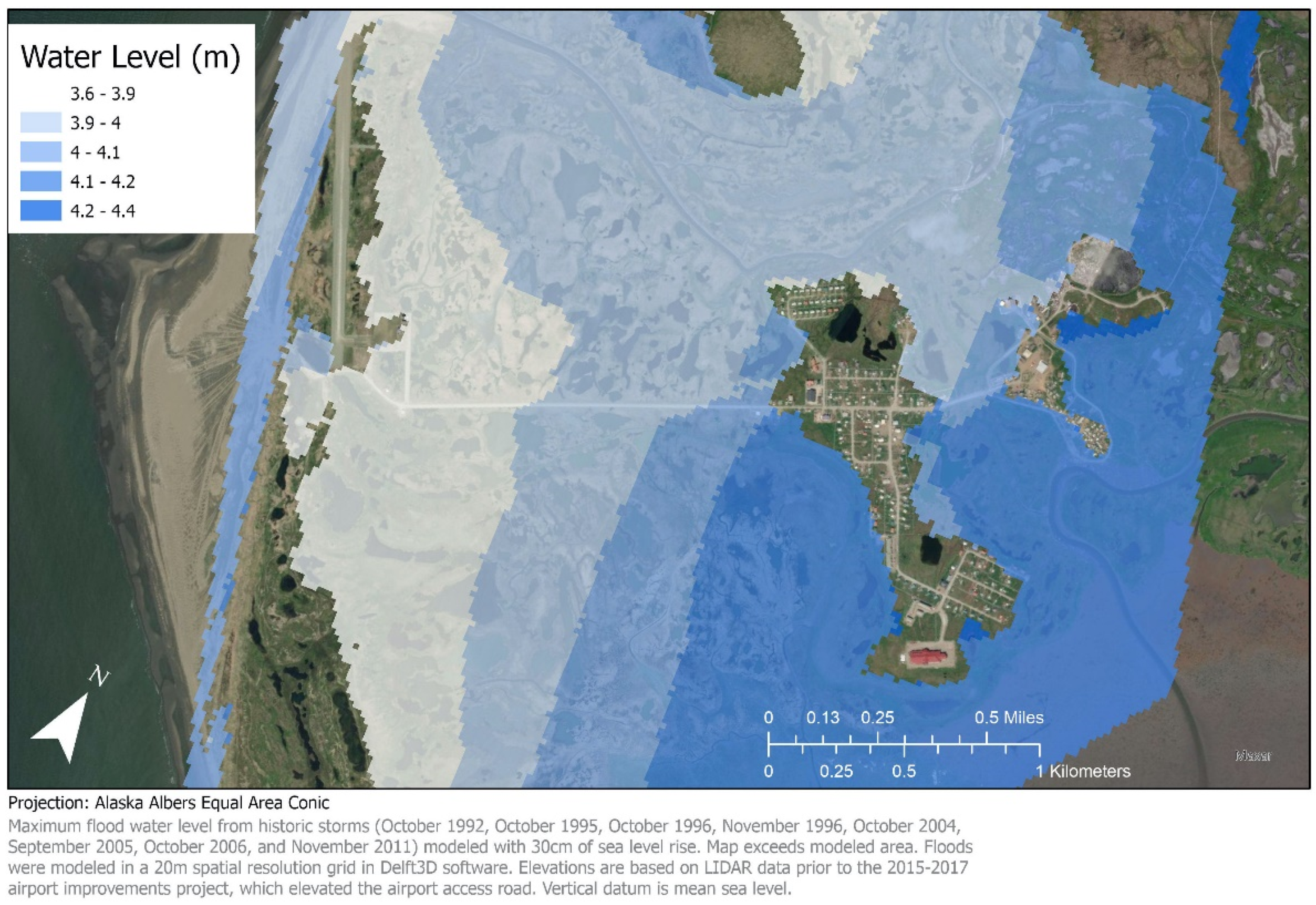1. Introduction
Rising sea levels have created a critical new question for policymakers: assuming limited federal funding, how do we choose which communities to protect? Climate change in the form of sea level rise (SLR) and land subsidence is increasing relative sea levels in western and northern Alaska, and there is little consensus on how best to respond [
1]. A General Accounting Office study found that 184 (86%) of Alaska Native villages were already impacted by flooding and erosion to some extent, and that four (Kivalina, Koyukuk, Newtok, and Shishmaref) were in imminent danger [
2]. Flooding and erosion impacts are likely to worsen with sea level rise, and these communities, like many in the U.S., do not have the internal funds necessary to protect themselves. It is likely that the fate of these coastal communities will be determined largely by how federal and state agencies choose to distribute aid. Policymakers need to consider which villages will get funding, what mitigation strategies to employ, and how to provide the best quality of life and exit strategy for those whom funding does not cover. Options currently under consideration for the threatened communities are to create protective infrastructure, to relocate the communities, or to co-locate residents to existing communities.
Despite the urgency of this issue, there is no consensus on how to distribute funds or when to use different mitigation strategies. A paper by the Brookings Institute (2013) found that in Alaska, “There is no adaptive governance framework in place to evaluate when communities and government agencies need to shift their work from protection in place to community relocation.” There is a need for supporting research to provide more information on what risks these places will face, and what the potential costs may be, to help inform decision making.
Broader decision-making frameworks benefit from data at the community level. This paper explores that community-level assessment; risks of road flooding in the Hooper Bay community are evaluated and associated with their mitigation costs. This could be expanded to risks for additional infrastructure and coastal hazards and generate information to support multi-community funding decisions. Similar, community-level flood risks were estimated for the California [
3]. Their work was based on the Coastal Storm Modeling System (CoSMoS), a suite of hydrodynamic models including Delft3D [
4] and Xbeach [
5], which computed the wave run-up and setup, and the consequent coastal flooding. Using wind and pressure forcing from global climate models, and accounting for sea level rise, CoSMoS predicts the coastal flood risk based on assumed valuations of coastal infrastructure. Lantz et al. provide storm-surge inundation risk for three coastal communities on the North Slope of Alaska, but their work over-calculates risk as it is a static calculation based on topography and surge height alone [
6]. Actual coastal flooding is a dynamic hydrodynamic process, and flood waters require time to propagate across the land surface. Ravens and Allen used a hydrodynamic model (Delft3D) to compute coastal inundation on the Yukon-Kuskokwim Delta for historic storms, finding that flood waters required several hours to inundate the delta plain [
7]. Assuming flooding of all coastal locations with elevations less than the peak surge heights leads to an overestimate of the flood risk.
The 2019 Intergovernmental Panel on Climate Change report indicates that the global mean sea level (GMSL) will rise 0.24–0.32 m by 2050, relative to levels in 2000, with relatively low uncertainty. Uncertainty increases with longer term projections from uncertainty of future emissions—medium confidence estimates range between 0.43–0.84 m by 2100. Each of these estimates uses the averages of results from two carbon emission scenarios—Representative Concentration Pathway (RCP)2.6 and RCP8.5—to define the range. The full range for RCP8.5—the scenario in which there is no great effort to reduce carbon emissions—is 0.61–1.10 m in 2100, with a possible GMSL of 2 m.
In Alaska, glacial isostatic adjustment from the last ice age, as well as recent glacial retreat, has created uplift, especially in south-central Alaska. A NOAA technical report found that relative sea level (RSL) rise along much of the Alaskan coast will be less than the predicted GMSL, primarily because of this uplift, in low and intermediate sea level rise scenarios (up to 1 m GMSL by 2100) [
8]. However, on the Yukon-Kuskokwim Delta specifically, the report found RSL to be nearly equivalent to GMSL, or higher than GMSL in high and extreme scenarios.
The Yukon-Kuskokwim Delta (YKD) has low elevation and experiences frequent storms, making it particularly vulnerable to storm-surge flooding and climate change impacts. Prior to the mid-1900s mandate that Alaska Native children attend federally regulated schools, Alaska Native communities migrated between the coasts and central Alaska to follow fish and game [
9]; following the mandate, permanent coastal habitations were created, sometimes in locations only intended as summer camps. Besides sea level rise, these coastal communities face climatic threats from the effects of melting permafrost, salinization, erosion, and changing ecosystems impacting a subsistence-based lifestyle. Terenzi et al. found that flooding appears to be more frequent on the YKD than other coastal areas of Arctic Alaska and Canada, probably because of the relatively low elevation (about 2 m relative to mean sea level) and the significant tidal range (2.7 m) [
10].
Hooper Bay is a city and Native Village of 1375 people [
11] on the Yukon-Kuskokwim (YK) Delta that experiences annual flooding from storm surges (
Figure 1). The YK Delta lies on the Bering Sea, and this sea marks the southern portion of the U.S. Arctic [
12]. The community is divided into the northeast “Old Town” (61°31′52″ N, 166°5′45″ W) and southwest “New Town” (61°31′40″ N, 166°6′32″ W) connected to each other and to the airstrip by Airport Road. In 2017, the town finished a construction project that fortified the airstrip against coastal erosion and elevated the airport access road between New Town and the airstrip, improving airport accessibility during storms. The as-built plans for this project and the compilation of bids provided critical information for this study.
Aside from elevating roads, communities may take any number of steps to provide flood protection. Flood evaluations for Shishmaref [
13] compare community relocation to a new site to co-location with an existing community or creating protective measures at the original site. Relocation might take place all at once, as Newtok is doing in its move to Mertarvik, or in a staged retreat, when the community plans new infrastructure on nearby high ground while abandoning or demolishing threatened structures in a slow migration. Other options for site protection include elevating homes, creating dikes, or bolstering natural protective features at the site.
Government agencies, including the Army Corps of Engineers, have been aware of the climactic threats to coastal Alaska for some time. A 2003 Government Accountability Office study identified all the Alaska Native villages experiencing flooding and erosion and noted problems with existing relief structures [
2]. Many villages do not qualify for assistance because they do not meet cost/benefit requirements (existing infrastructure has less total value than the proposed protection measures) or cost-share requirements, where the village must fund 25–50% of the project costs. Government agencies do not consistently coordinate their efforts with community plans, and money is spent on infrastructure in communities planning to relocate. Additionally, there is a lack of gauging stations and flood extent data in most villages, so that it is difficult to rank and assess communities outside of those with the direst need. The Federal Emergency Management Agency (FEMA) publishes flood maps for communities, but only if they opt into the National Flood Insurance Program (they do not have a map for Hooper Bay).
A 2013 paper from the Brookings Institute reviewed the government response to the threatened villages and identified key challenges [
9]. A stand-out note is that there is currently no structure to decide when communities need to relocate vs. armor in place, and therefore protection infrastructure is being constructed in communities that may only last a few years before the strategy shifts to relocation. There is a need for decision-making frameworks to assist in evaluating the costs of climate change.
5. Discussion and Conclusions
The Hooper Bay case study investigated the annual road flood exposure with sea level rise, estimated a unit cost of flood exposure, and the costs of potential mitigation measures. Flood exposure was determined by modeling historic storms and re-modeling them with simulated sea level rise, estimating the flood exposure return periods, mapping the flood exposure, and applying the return periods to flooded observation points to calculate the annual flood exposure. Unit cost was found by estimating the access road elevation costs from the Airport Improvements Project, determining the number of years the elevation project was likely to be effective, and calculating the annual flood exposure that would have occurred without the elevation between 2020–2050. An estimate of the annual cost of flooding (for 2020–2050) was calculated by taking the product of the unit cost of flood exposure and the annual flood exposure. Finally, the community road flooding protection costs were calculated by roughly designing three possible mitigation routes (road elevation, putting dikes along the roadways, and creating a large dike that creates polders near the community), estimating the costs of the options based on the Airport Improvements Project, and estimating the resulting AFE.
The extreme value analysis used flood water level to estimate the return period of floods, rather than the kilometer-hours of inundation used later in the study. The kilometer-hours metric is specific to measuring the flood impact on roads and is limited to the observation points chosen for this study—if other infrastructure (for example, a power plant that can never be allowed to flood) is examined, the kilometer-hours of road flooding will be irrelevant to it. By using the maximum water level over the whole community, a more equitable return period is assessed. This may not be the ideal measurement for flooding—floods can cause impact because of duration or current speed, as well as depth. The model area also included ground not essential to the community; storms that caused no flooding in the community might be rated more highly than deserved when the maximum water level is taken from the entire model area (the October 1996 flood, which never touched the community, had a maximum level of 3.06 m). Additional work is needed to determine what metric may align best with flood impact in the whole community.
The large confidence intervals on the extreme value analysis reflect the small sample size and speak to a need for a better method of estimating the return period of flooding. As we have seen, the extent of flooding is not directly linked to storm-surge height. There is a need for additional coastal flood modeling on the Yukon-Kuskokwim Delta to better determine how sea level rise will affect the coastal communities and provide larger sample sizes for this type of analysis.
Mapping the maximum flood water depth had several interesting results. Large stretches of the area experience flood depths within 10 cm of each other, reflecting the very flat ground around Hooper Bay. The maps also appear to corroborate the hypothesis from watching the flood animations that the flooding mostly comes from east of the community. Finally, the map of the flood line shows how the flood waters are likely to rise in the community over time, turning Old Town and New Town into separated islands.
The annual flood exposure analysis demonstrated the success of the airport access road elevation project; not only did it reduce flooding on the airport road to near 0 for the baseline and 30 cm SLR scenarios, the AFE for the entire community was greatly reduced, showing the high impact of the project. With the assumed scenario of 30 cm of SLR in Hooper Bay in 2050, this indicates that the airport access road will begin experiencing storm-surge flooding in just under 30 years.
Comparing the costs of the mitigation measures showed that building a dike may be the best option for the community to mitigate flooding through 2050. The roadside dike is estimated to be the cheapest option. However, it should also be noted that the larger dikes, which cost roughly USD100,000 more than the roadside dike, have the benefit of creating a polder between Old Town and New Town, reclaiming some land from flooding, and possibly enabling community expansion—though further elevation or a pump system in this area may be necessary to make the land fully habitable. The larger dikes also cross stretches of wetlands, which may lead to additional expenses from permitting.
From the cost estimate analysis, it is clear that a large portion of the construction costs are due to set-up and over-head, bringing in construction equipment, sheltering the crew, and other flat costs that incur regardless of project size. This means that to save on costs it may make sense to plan multiple projects to happen simultaneously or sequentially—for example, planning all road elevations to happen at once.
Applying the unit cost of flood exposure to the flood exposure of the entire community resulted in an estimate about USD4.2 million greater than the cost estimate based on the Hooper Bay Airport improvement project. A large part of this is from the set-up and overhead costs, which were assumed to be the same for both elevating the access road and elevating all the roads and amounted to USD3,590,700 (37–45% of total project costs). The community mitigation measure has a lower percentage of these set-up costs in its total project costs than the access road project, and this translates to an overestimate of USD2,698,600 (64% of the difference between the two estimates). The remaining difference may be from poor assumptions of cost drivers in the cost estimation (e.g., that surveying costs scale linearly).
This again demonstrates the possible advantages of doing multiple projects at once; the set-up costs can be minimized. However, this does not show the political advantage that may come from doing smaller, distinct projects over time. Multiple projects simultaneously will have a higher total price tag at the outset compared to smaller projects, and may be easier to acquire funding for, even though they are more expensive over the long term. This is analogous to the decision to relocate, which is very expensive but may absolve all coastal threats.
This research explored a method of evaluating flood risk for coastal Alaska, leveraging flood modeling to determine the flood exposure that the community will face in the coming years. It additionally explored a unit cost of flood exposure, associating flood exposure with its cost of mitigation, and examined three different methods of approaching flood mitigation in Hooper Bay. This showed the flooding that Hooper Bay is likely to experience in the coming years, the possible costs of mitigation, and an apparent advantage for constructing dikes to protect the community compared to elevating all roadways.
This study is non-comprehensive and could greatly benefit from future work. In the Hooper Bay study, future work could improve flood severity return-period analysis. It was shown that flood severity is not directly correlated to storm-surge height because of other factors like storm direction of approach, such that storm surge return periods do not necessarily predict flooding severity. However, a shortage of storm-flooding data points means that applying extreme value theory directly to floods results in return periods with great uncertainty. Future work could identify factors that, combined with storm surge, predict flood severity, so that those factors could be used to estimate the flood-return period. Alternatively, additional modeling could be done to expand the number of data points, though this may be time and resource intensive.
It was assumed that road-flooding impact can be evaluated through kilometer-hours of flooding, and that the allowable amount of flooding is 0 km hours on the airport road. Using kilometers is an approximate for flood extent, and therefore general community impact. More complicated road networks, where flooding one road has greater impact than another, may need more complex systems analysis to develop a metric. Community communication and surveying are necessary to determine the true allowable annual flood exposure; the community currently experiences 3.2 km hours of flooding per year, but whether this is acceptable is unknown. The study should also be expanded to include additional infrastructure and evaluate erosion and permafrost melt impacts to obtain a more holistic picture of community impact.
Construction cost-estimation could be improved by compiling data from a greater number of projects from the Yukon-Kuskokwim Delta; this could better inform the costs of flood mitigation, and therefore the best strategies for each community. A greater variety of project types should be considered, including utilizing natural features, or combining multiple smaller projects (elevating one section of road, building a short dike somewhere else, etc.). Projects could also be framed for multiple time planning periods by designing to the shorter period and then calculating the cost it would take to improve the project to meet protection levels for the following planning period. Project maintenance costs should also be considered—in this case study, the costs of road and dike upkeep could shift the outcome.
The unit cost of flood exposure could be improved by separating the overhead/lump sum costs from the material costs. The material costs could be approximated through a unitized cost, but lump costs that depend on how a project is split up need to be evaluated separately to avoid over-counting them, as has happened in this study.
The unit cost of flood exposure was originally conceived as a way to estimate the flood risk (cost, USD/y) in multiple communities in a given region. Assuming that the unit cost of flood exposure was reasonably valid for a given region, one could compute the annual flood exposure for each community, and take the product of unit cost of flood exposure and annual flood exposure for each community. This calculation would enable a reasonably objective assessment of the flood risk (USD/y) in multiple communities. Furthermore, if a community-specific unit cost of flood exposure is divided by the population served by the flood mitigation (yielding USD/(kilometer-hours-person) units), a cost-benefit ratio emerges that could be an objective basis for decisions about where to invest in flood mitigation.
